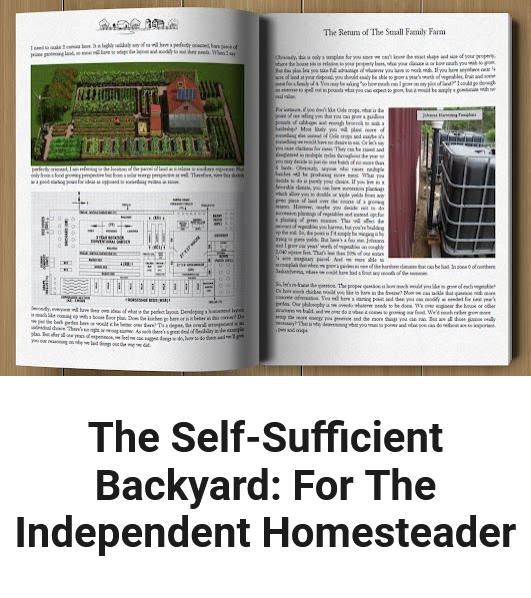Looking for a guide to homesteading for beginners? You’re in the right place.
Homesteading offers a way to live independently and reconnect with the land.
Over the past decade, more people have embraced this lifestyle, discovering the rewards of growing their own food, raising animals, and becoming more self-sufficient.
Starting out may seem overwhelming, but it’s a journey that can unfold at your own pace.
You don’t need a large rural property to begin. Whether you have a small backyard or a limited city space, homesteading is about adapting to your environment and taking manageable steps.
Along the way, you’ll learn how to preserve food, manage resources, and embrace sustainable practices.
The good news is that there’s a wealth of resources available to guide you, from books and online guides to local workshops and community groups — each offering hands-on advice to help you succeed.
Homesteading for Beginners Quick Guide
Modern homesteading has evolved into a flexible and accessible lifestyle choice, with options ranging from urban gardens to full rural properties. The movement emphasizes self-sufficiency through skills like gardening, animal husbandry, and food preservation, making it possible to start small and gradually expand your capabilities.
Financial planning and sustainable practices form the backbone of successful homesteading, with many practitioners finding innovative ways to generate income through value-added products and educational experiences. The importance of community cannot be overstated, as 78% of new homesteaders initially feel overwhelmed, but find success through local networks, workshops, and knowledge sharing.
Essential skills like water management, energy conservation, and natural health practices contribute to a well-rounded homestead, while basic animal husbandry can provide sustainable food sources for families. A well-planned homestead layout incorporating permaculture principles and careful consideration of local regulations ensures long-term success in this rewarding lifestyle.
Understanding Modern Homesteading
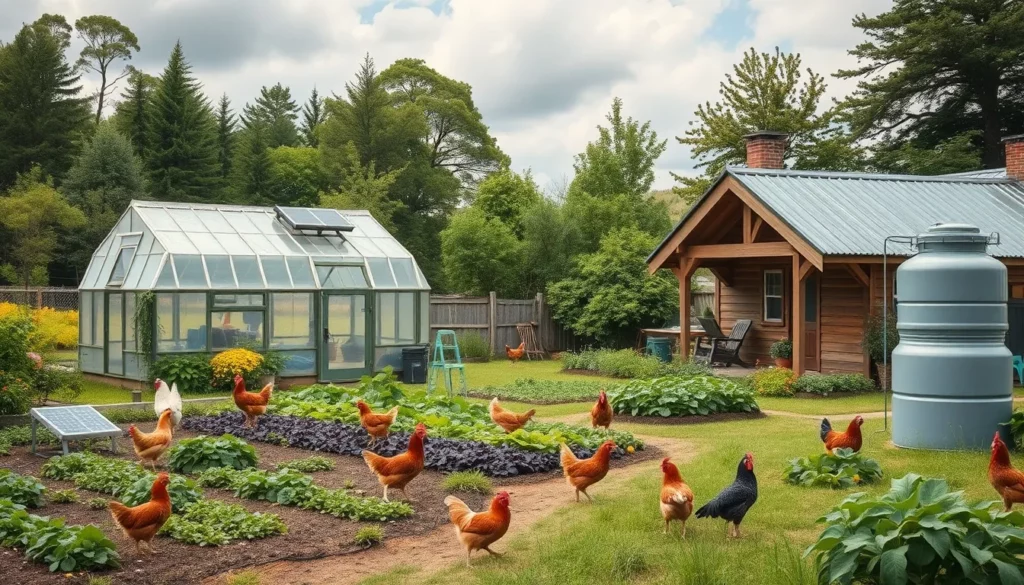
Modern homesteading is all about self-sufficiency and sustainability, but it’s far from a one-size-fits-all approach.
The concept has evolved to fit different lifestyles, whether you’re living in a bustling city or a quiet rural area.
People are finding ways to grow food, raise animals, and live more consciously no matter where they are.
Urban Homesteading
Urban homesteading is gaining momentum as more people adapt their small spaces for food production.
It’s not uncommon to see gardens on balconies or in backyards, where vegetables thrive and chickens roam.
In fact, many cities have started to relax restrictions, allowing residents to keep hens and harvest eggs right from their own homes.
This shift reflects a growing desire to reconnect with the origins of our food and reduce dependence on store-bought goods.
Off-grid Living
Off-grid living, on the other hand, takes sustainability to another level.
Individuals choosing this path often focus on generating their own energy through solar panels, harvesting rainwater, and building homes that minimize their environmental footprint.
The goal is to live in a way that’s not only independent of the grid but also deeply in tune with the natural world. This lifestyle emphasizes simplicity and sustainability, with an eye toward long-term environmental stewardship.
Getting Started with Homesteading: A Beginners' Guide
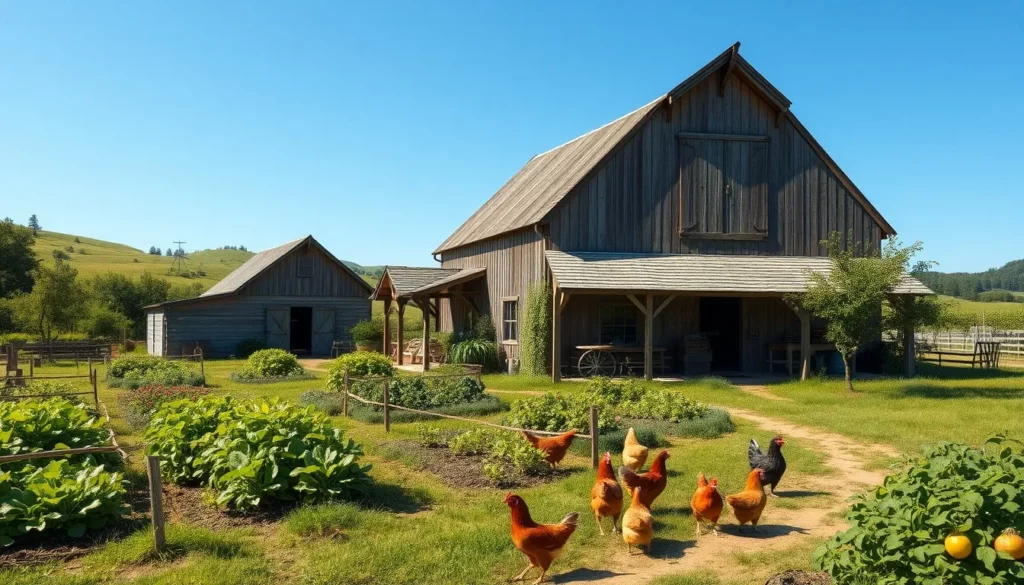
Starting your homesteading journey doesn’t require a vast plot of land.
Even a small area can yield impressive results with the right approach.
The key is to take a step back and figure out what you truly want from your homestead.
Are you interested in growing your own vegetables, raising chickens, or diving into the principles of permaculture? Start with what excites you most and build from there.
You don’t need to master everything overnight.
Homesteading is a skill set that grows over time, and the learning process is part of the fun.
Knowledge is a powerful tool on this journey, so embrace learning.
Read books, follow blogs, and watch videos on homesteading topics that catch your interest.
Also, look for local communities or online groups where you can connect with experienced homesteaders. They often have practical tips and can offer advice when you hit a bump in the road.
Step #1: Knowing How Much Does it Cost to Start a Homestead
Starting a homestead is a significant investment that requires careful financial planning. Here are some estimations for your guideline:
Land and infrastructure
Starting a homestead begins with securing suitable property, typically requiring 2-5 acres minimum.
Rural land costs range from $1,000 to $10,000 per acre, while developed areas may exceed $20,000 per acre.
Essential infrastructure follows:
- Well drilling ($5,000-$15,000)
- Septic system installation ($3,000-$9,000)
- And utility connections ($1,000-$5,000)
Basic shelter is crucial, with even modest dwellings costing between $30,000 and $100,000.
This foundational phase typically represents the largest portion of your investment, ranging from $41,000 to $179,000 depending on location and property size.
Equipment and facilities
The second major investment category covers the tools and structures needed to operate your homestead.
A basic set of hand tools ($500-$1,000) forms your daily working foundation.
Larger equipment like a small tractor or tiller adds $2,000-$10,000 to your budget.
Property fencing, essential for security and future livestock, costs approximately $1,500-$3,000 per acre.
Storage solutions are also crucial – a basic shed for equipment and supplies typically runs $1,000-$3,000.
This equipment and facilities phase generally totals between $5,000 and $17,000 for a modest setup.
Agricultural and livestock startup
The final phase involves setting up your food production systems.
A basic garden setup requires $500-$1,000 for soil preparation, irrigation, and basic tools, plus $200-$400 for initial seeds and plants.
For those interested in raising chickens, a coop and small flock of 10 birds costs between $500-$1,000.
The most modest investment for agriculture and livestock startup thus stands at $1,200-$2,400,
These costs can increase significantly if you plan to add more livestock or expand your growing operations.
Total investment overview:
- Complete startup with land purchase: $50,000-$150,000
- Startup excluding land (if already owned): $15,000-$40,000
- Minimum viable startup (very basic): $10,000-$20,000
Keep in mind that these ranges are averages, and actual costs can vary significantly based on location, scale, and how much work you’re willing to do yourself.
Many successful homesteaders start small and expand gradually, spreading costs over time while gaining valuable experience.
Step #2: Choose Your Homestead Location
When choosing a location for your homestead, consider what fits your lifestyle and goals.
Rural properties offer wide-open spaces, plenty of privacy, and the freedom to expand.
However, they can also be remote, which means fewer amenities and services nearby.
For some, the isolation might be exactly what they’re looking for; for others, it might feel a bit too disconnected.
On the other hand, urban homesteading allows you to stay close to everything you need; grocery stores, healthcare, schools, and other essential services.
Many cities support sustainable living with resources like composting programs and vibrant farmer’s markets.
Urban spaces may feel more connected, but you can still embrace self-sufficiency through creative solutions like rooftop gardens, vertical farming, or community gardens.
Before making a decision, think about the kind of lifestyle you want to lead and how self-sufficient you aim to be.
Another important factor to consider is local regulations.
Zoning laws and ordinances can vary widely from place to place, so it’s essential to research what’s allowed in your area.
Local laws may influence what you can or can’t do on your property, such as keeping livestock or starting a garden.
Certain states — such as Oregon, Washington, Tennessee, Vermont, and Maine — are known for being homesteading-friendly, offering supportive communities and ample land for growing and raising animals.
Take your time to explore your options, because your homestead’s location will play a significant role in shaping your experience.
Step #3: Plan Your Homestead Layout
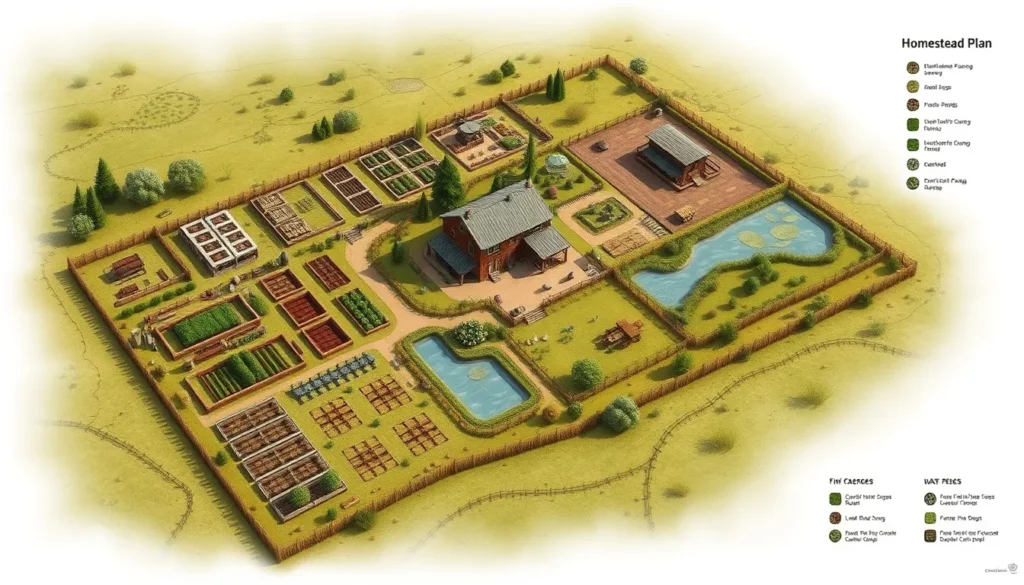
A well-planned homestead design is essential for a sustainable farm layout. Think about the space you have and what you want to achieve.
For small urban plots, use vertical gardening and container gardens to save space. Larger areas can have different zones for gardening, livestock, and wild spaces for foraging.
Permaculture
Incorporating permaculture principles into your design will help you create a self-sustaining system that works with nature, not against it.
Start by placing your vegetable garden close to your home, ideally where it can receive 6 to 8 hours of sunlight a day and benefit from good drainage. These areas should be easily accessible for frequent care and harvesting.
Livestock
If you plan to raise livestock, think carefully about how much land you have.
Small properties under an acre are perfect for animals like chickens, ducks, turkeys, and rabbits. These animals don’t require vast amounts of space and can often thrive in more compact areas.
For larger homesteads — those with 5 acres or more — you can consider raising bigger animals like cows, sheep, and goats.
When designing for livestock, remember that shelters should be placed farther from the house but still close enough for regular management.
Careful planning of these elements helps create a functional homestead that maximizes available space while ensuring the long-term health and productivity of your land.
Take time to observe how your space is used and adjust your layout as you go, understanding that the best design evolves as you gain experience and insight into what works best for you.
Step #3: Learn Essential Homesteading Skills

Homesteadingneeds a variety of DIY skills to live off the land and use less modern stuff.
Learning these skills below is a rewarding journey that connects you to traditional crafts and a simpler life.
Gardening skills
Starting your first vegetable garden can be an incredibly rewarding experience, especially for those just beginning their homesteading journey.
Many beginners, around 87%, are excited to grow their own food at home, but it’s important to remember that success lies in starting small and taking the time to plan.
Choosing the right spot and preparing the soil
Starting your first vegetable garden begins with finding the right location.
Look for an area that gets plenty of sunlight, ideally at least 6 hours a day.
The soil should also drain well, as most vegetables don’t like “wet feet” (soil that stays too moist).
Once you have your garden site, it’s time to prepare the soil.
One of the best ways to improve the soil is by composting organic matter, such as kitchen scraps and yard waste.
Compost provides the essential nutrients your plants need to grow strong and healthy. This natural fertilizer is also a great way to reduce waste while nourishing your garden.
Choosing plants and natural pest control
When you’re just starting out, it’s best to keep things simple.
Opt for easy-to-grow vegetables like tomatoes, lettuce, and herbs. These are forgiving and don’t require too much attention.
Consider companion planting, which pairs certain plants together to naturally repel pests.
For example, planting basil near your tomatoes can help deter insects while also improving the flavor of your tomatoes. This kind of natural pest control minimizes the need for harmful chemicals, making your garden more sustainable.
Watering, tracking progress and expanding over time
Watering efficiently is essential, especially as you learn the ropes.
Mulching can help retain moisture in the soil, and using drip irrigation ensures that water goes exactly where it’s needed — at the plant roots.
Keeping a garden journal can help you track your progress and identify what works best for your growing conditions. This journal can also become a valuable resource for planning next season’s garden.
As you gain experience, you can expand your garden, try new plants, and experiment with more advanced techniques.
Raising chicken skills
Backyard chicken keeping is becoming more popular as egg prices rise. Many people start with a few hens and then grow their flock. This surge in demand has caused hatcheries to run out of chicks.
Creating the Right Living Space for Your Chickens
When raising backyard chickens, the first thing to think about is space.
Your chickens need enough room to move around comfortably, which will help keep them healthy and happy.
The general rule of thumb is to provide 3 to 4 square feet of space per bird in the coop, and they also need about 10 to 12 inches of roosting space to sleep off the ground.
If your chickens are kept inside for any reason, give them about 10 square feet per bird to prevent overcrowding, which can lead to stress and health issues.
A well-ventilated, clean, and secure coop is crucial.
Make sure to add bedding like straw or wood shavings to absorb waste and keep things dry.
Don’t forget about access to fresh water—your chickens need around a cup of water each day to stay hydrated and maintain good egg production.
Make sure their water is clean and accessible at all times, as dehydration can seriously affect both their health and your egg supply.
Feeding and maintaining a balanced diet
What you feed your chickens plays a huge role in their overall well-being.
To keep them strong and productive, they need a protein-rich diet. Aim for a feed that contains between 12% and 20% protein content.
Each chicken requires about 1/4 to 1/3 pound of food per day. You’ll need to monitor how much they eat and adjust their portions if necessary, as chickens’ appetites can fluctuate.
If you want to save on feed costs, consider fermenting or foddering their feed.
Both options can stretch your budget while offering your chickens extra nutrients.
You’ll also want to keep an eye on the quality of their eggshells — weak shells are often a sign of calcium deficiency. If that happens, add crushed eggshells or oyster shells to their diet to provide the extra calcium they need.
Protecting your flock
Raising chickens means staying on top of their health and making sure they stay disease-free.
A strict biosecurity plan is essential.
One of the most important practices is quarantining any new birds before introducing them to your flock. This helps to prevent introducing any respiratory or contagious diseases.
Chickens are also prone to external parasites like mites and lice, so regular dust baths are an excellent way to keep them clean and free from pests.
Be vigilant for common health problems like bumblefoot (a foot infection) or respiratory issues.
If you catch them early, most health problems are easy to manage.
With the right care and attention, your chickens will reward you with fresh eggs while also helping to keep grocery bills down.
GRAB 5 FREE SHED PLANS NOW!
Food preservation skills
Preserving food is vital for keeping your harvest fresh all year. Canning, dehydrating, fermenting and storing food properly are must-know skills.
Canning
Canning is a key skill for any homesteader looking to extend the life of their harvest.
There are two main methods:
- Water bath canning: works well for acidic foods like tomatoes, fruits, and jams. This method is straightforward, requiring a pot of boiling water to process jars of food.
- Pressure canning: essential for low-acid foods such as vegetables, meats, and poultry. The higher temperatures reached in a pressure canner ensure that harmful bacteria are destroyed, making these foods safe for long-term storage.
To get started, invest in a quality canner, jars, and lids.
Following proper safety guidelines is crucial to prevent spoilage and contamination.
Keep an eye on processing times and make sure your jars seal correctly. Once you get the hang of it, you’ll have a pantry stocked with homemade preserves that can last for months, if not longer.
Dehydrating
Dehydrating food works by removing moisture from foods like fruits, vegetables, and even meats, which prevents the growth of spoilage-causing bacteria.
Dehydrated foods can last for months or even years when stored in airtight containers, making it an efficient and long-lasting option.
Using a dehydrator is the easiest way to dry your food, but you can also use an oven or even air-dry in certain conditions.
When dehydrating, be mindful of the thickness and size of your pieces for consistent drying.
Once dried, store foods in dark, cool places to retain flavor and nutrition. Root vegetables and squash are excellent candidates for dehydration and can be rehydrated later to use in soups, stews, or casseroles.
Fermenting
Fermentation is an ancient preservation technique that not only keeps food safe but also enhances its nutritional value by adding beneficial probiotics.
Foods like sauerkraut, kimchi, and pickles are all made through fermentation, which can be a fun and rewarding process to experiment with.
As you get more comfortable, you can try fermenting a wider range of foods, including dairy products like yogurt and kefir, or even fermented beverages like kombucha.
Storing food properly
Proper food storage is essential to prevent spoilage.
Organizing your pantry is key to making sure that your preserved foods are easy to access and that you’re using older items first.
Label your jars and containers with the date they were preserved to ensure you consume them within their optimal storage time.
A well-maintained food preservation system will help you reduce waste and make the most out of your homegrown produce all year long.
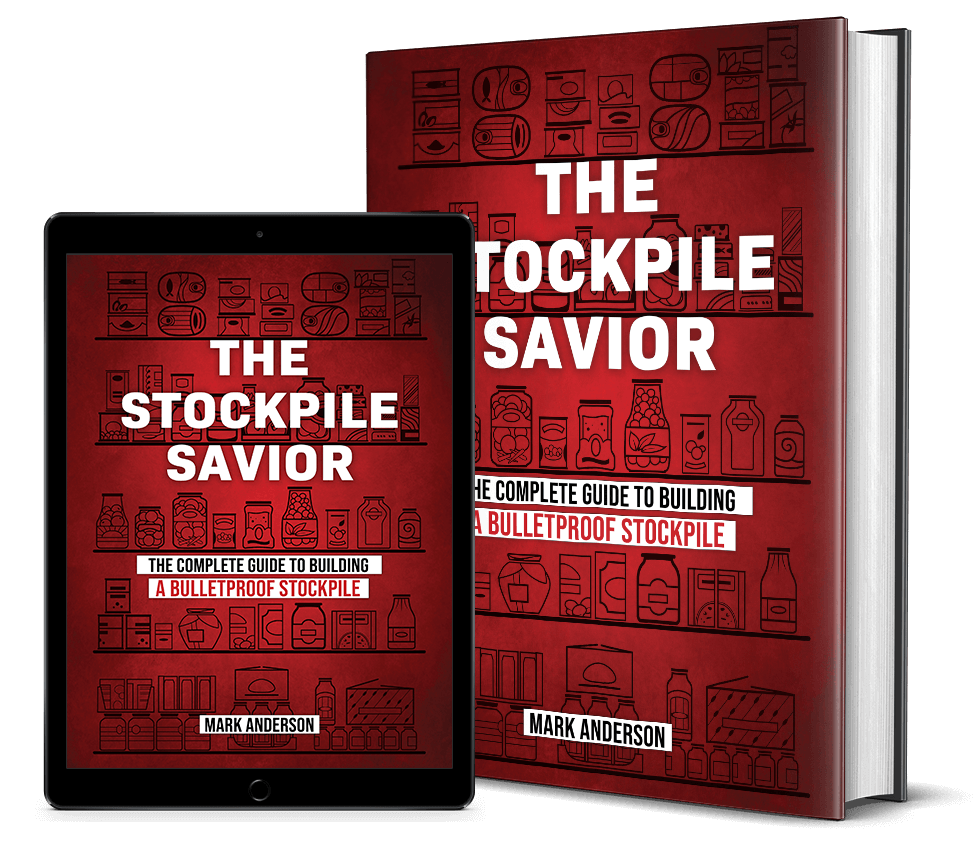
Discover how to build a 100+ days stockpile from scratch, in under 10 days!
This is the ultimate guide to building a bulletproof stockpile that takes you from being uncertain about your preps to being 100% confident that your family will comfortably survive the first 100 days & beyond of any disaster.
Alternative and sustainable energy skills
A crucial homesteading skill, especially for those who want to go off-grid, is finding ways to use energy that’s good for the planet.
Solar power
Solar energy remains one of the most accessible and eco-friendly power sources for off-grid living.
With solar panels installed on rooftops or ground-mounted racks, you can generate electricity without relying on traditional power grids.
Even on overcast days, modern solar panels can still capture sunlight and produce energy, making them a reliable option year-round.
Not only does solar power reduce your reliance on fossil fuels, but it also lowers your carbon footprint, providing a cleaner and greener energy alternative.
For those who are new to solar power, the initial investment can be significant, but the long-term savings and environmental benefits make it well worth it.
Over time, solar energy can pay for itself, especially as technology improves and prices continue to drop.
Once your system is set up, you’ll enjoy the peace of mind that comes with knowing your energy is coming from a renewable resource.

Cut Your Power Bills By 65%!
The simplest, easiest-to-use A to Z blueprint that anyone can follow to make their own cheap green electricity.
Wind and water power
If your homestead is located in an area with consistent winds, wind turbines are a great option for generating renewable energy. These turbines can complement solar power systems, ensuring a steady supply of electricity throughout the day and night.
Wind power is particularly useful for off-grid homes in rural areas where wind speeds are more reliable, providing an extra layer of energy security.
Another effective and often underutilized energy source is micro-hydro power.
If you live near a stream or river with flowing water, you could harness that water’s energy to generate electricity.
Micro-hydro systems are incredibly efficient, producing a constant source of power. While installation can be more complex, if you have the right location, this can be one of the most reliable and sustainable methods of powering your homestead.
Waste-to-energy solutions
While generating renewable energy is crucial, reducing energy consumption is equally important. Implementing energy-efficient design features in your home can significantly lower your energy needs.
For example, incorporating passive solar design helps take advantage of natural heating and cooling, minimizing the need for artificial temperature control.
Using energy-saving appliances and LED lighting further reduces power consumption, ensuring that every bit of energy you produce is used efficiently.
Another innovative solution is biogas systems, which convert organic waste into fuel. These systems can be used to power stoves, heating, and even generate electricity.
By turning food scraps, manure, and other organic materials into usable energy, you not only reduce waste but also enhance your homestead’s self-sufficiency.
This circular approach to waste management and energy production embodies the essence of sustainable living, allowing you to make the most of what you have while minimizing your environmental impact.
Water collecting and management skills
Water is very important on any homestead. With water scarcity affecting two-thirds of the world’s people, smart water use is crucial.
Rainwater harvesting and greywater systems
One of the best ways to reduce reliance on municipal water is through rainwater harvesting.
By installing rain barrels or a more elaborate rainwater collection system, you can capture rainwater from rooftops and store it for later use. This collected water is perfect for irrigating gardens and watering animals, helping you conserve valuable freshwater for more essential uses.
Greywater systems are another practical solution for saving water. These systems repurpose water from household activities such as washing dishes, taking showers, or doing laundry, and use it to water plants.
Since a significant portion of household water is used outdoors, redirecting greywater helps cut down on consumption.
By setting up a simple filtration system, you can effectively reuse this water, reducing both your water bill and your environmental impact.

Create Your Own Water Supply!
EXCLUSIVE step-by-step guide showing you EXACTLY how to create your own “home oasis” TODAY and how to survive any tough century long drought!
Efficient watering techniques
Water conservation isn’t just about collecting and reusing water; it’s also about using it wisely.
One of the most effective ways to reduce water usage in your garden is by choosing native plants. These plants are naturally adapted to your local climate, which means they require less water and attention.
They thrive in local conditions, reducing the need for constant irrigation.
For lawns or larger areas of plants, deep watering is another technique that promotes healthier, longer-lasting growth. Instead of frequent shallow watering, watering deeply allows roots to grow stronger and plants to endure longer dry spells.
Additionally, improving your soil’s water retention capabilities is key.
Regular soil analysis helps you understand your soil’s needs.
Adding organic matter like compost increases the soil’s ability to hold moisture, which means your plants won’t require as much water. This approach not only promotes plant health but also reduces water waste, making your homestead more sustainable in the long run.
By combining thoughtful watering strategies with soil improvements, you can manage your water use efficiently and keep your homestead thriving even during dry spells.
Building a Homestead Kitchen
A well-organized homestead kitchen is more than just a place to cook — it’s where you transform the fruits of your labor into meals, preserves, and homemade goods.
Start by designing a space that suits both daily cooking and larger tasks like canning or food processing.
The layout should prioritize easy movement and efficiency.
Aim for ample counter space that allows you to prepare, chop, and process food without feeling cramped.
The classic work triangle, where the stove, sink, and refrigerator are placed within a 26-foot perimeter, will help streamline your cooking process.
Ideally, each side of this triangle should be between 4 and 9 feet, making it easy to access what you need without taking unnecessary steps.
If you find yourself doing a lot of specialized tasks like washing produce or prepping meats, consider adding a second sink in an island or workstation area.
This extra sink can help keep things organized and prevent the main sink from getting overloaded. It’s a small change that can make a big difference when you’re working with fresh ingredients or preserving large batches.
Investing in Quality Appliances and Storage Solutions
For a kitchen that can handle the demands of homesteading, it’s crucial to invest in durable appliances that can stand the test of time.
Gas ranges are particularly popular in homesteads because they offer reliability, especially when the power goes out. They also perform well during canning, where precise heat control is key.
A large farmhouse sink is another must-have, allowing you to wash big pots and bulk food for preservation without struggle.
In terms of storage, create dedicated spaces for your cooking tools and ingredients.
Deep drawers are perfect for stashing heavy pots and bowls, while smaller drawers help organize cutlery and utensils.
For your food storage, think about how to keep your herbs and produce fresh.
Consider a designated drying area for herbs and a root cellar or cool storage for vegetables and homemade ferments.
If you’re into preserving food, adding equipment like a dehydrator, pressure canner, or fermentation crocks will make your kitchen even more functional.
And if you’re eyeing expensive equipment like a cider press or large food processor, consider sharing costs with other homesteading families. This allows you to access high-end tools without the hefty price tag.
Building your dream kitchen doesn’t happen overnight. Take your time, set a budget for each year, and gradually invest in high-quality equipment.
Over time, you’ll create a kitchen that not only serves your daily cooking needs but also supports your farm-to-table lifestyle.
How to Make Money From Your Homestead
Turning your homestead into a profitable venture can be rewarding. Here are some money-making opportunities from your homestead:
Diversifying Income Through Produce Sales
One of the most straightforward ways to generate income from your homestead is by selling your surplus produce.
Farmers’ markets are a great place to start, offering you the opportunity to directly connect with your community and sell fresh, locally-grown goods.
If you’re consistent and strategic about your offerings, you could bring in a solid weekly income, anywhere from $500 to $1,000.
The key is to understand your local market’s preferences. Knowing what’s in demand and when will help you focus on the crops that will give you the best return.
You can also explore community-supported agriculture (CSA) programs, where members pay upfront for a share of your harvest. This approach not only provides a reliable income stream but also helps build a loyal customer base.
Creating Value-Added Products
Turning your raw produce into value-added products is a great way to increase your profits.
Instead of selling just tomatoes, for example, you could create sauces, salsas, or dried tomatoes.
Similarly, jams, pickles, and fermented foods often fetch higher prices than fresh produce, and they last longer, giving you a bigger window to sell.
Herbal products like homemade soaps, teas, or oils are also popular and can be easily made from what you already grow on your land.
Even baking can become a profitable venture.
Think fresh breads, pies, or pastries at the farmers’ market. These products can easily boost your weekly income, adding an extra $500 or more to your earnings, depending on your production capacity and local demand.
Exploring Niche Markets and Agritourism
Another way to boost your homestead income is by tapping into niche markets.
Offering heirloom varieties of fruits, vegetables, or flowers can attract customers who are looking for something unique.
Organic produce and ethically raised animal products also cater to growing consumer demand for more sustainable and healthy options.
Don’t overlook animal products like eggs, honey, or fiber, which are always in demand.
Fresh eggs, especially from free-range or pasture-raised hens, can sell for $5 a dozen, while specialty items like hatching eggs can fetch even higher prices, sometimes up to $25 per dozen.
Additionally, agritourism activities or educational workshops about farming and homesteading can help draw visitors to your property, creating another income stream.
If your location is suitable, you can host farm tours, workshops, or even farm-to-table dinners, offering a hands-on experience that’s increasingly popular in the world of agritourism.
Keep in mind the importance of complying with local regulations when selling food or offering experiences to ensure your business remains legal and sustainable.
Homesteading Community and Support Networks
Homesteading is rarely a solo endeavor; it thrives on the support and shared knowledge of a strong community.
When you’re starting out, it can be easy to feel overwhelmed by the many tasks and decisions that come with homesteading.
Joining local homesteading groups can provide much-needed guidance and camaraderie. These groups are often made up of people who have faced similar challenges and can offer practical advice.
Whether it’s learning how to build a chicken coop or understanding the basics of goat farming, these connections provide a wealth of knowledge that can help ease the learning curve.
Utilizing Resources and Learning Opportunities
In addition to local connections, the digital world offers numerous resources to expand your homesteading knowledge.
Online forums, social media groups, and specialized blogs are filled with tips, tutorials, and experiences shared by fellow homesteaders.
Many homesteaders also find value in taking part in workshops, classes, and farm tours. These hands-on learning experiences provide practical, real-world knowledge that can be essential for your success.
Studies show that a significant percentage of homesteaders find these learning opportunities extremely valuable, as they allow for a deeper understanding of the skills needed to thrive on a homestead.
The Importance of Mutual Support and Feedback
Homesteading groups create an environment where everyone can contribute, whether by sharing advice, lending a hand, or simply offering moral support.
As you grow your homestead, it’s important to stay open to feedback.
Many experienced homesteaders emphasize the importance of listening to others’ input, whether it’s a seasoned farmer giving advice on crop rotation or a new homesteader sharing a valuable tip on water conservation.
This reciprocal exchange of support and ideas not only strengthens your homesteading skills but also fosters a sense of belonging and collaboration within the community.
Conclusion
The journey into homesteading offers a unique blend of challenge and fulfillment that resonates deeply with those seeking a more intentional way of life.
From urban gardeners transforming their balconies into micro-farms to rural homesteaders managing vast acreage, this lifestyle adapts to fit nearly any situation or scale.
While the learning curve might seem steep at first – mastering everything from soil management to food preservation – the homesteading community stands ready to share their wisdom and support newcomers.
Success doesn’t require perfection or immediate mastery of every skill; instead, it grows naturally from small, deliberate steps toward greater self-reliance.
Whether you’re drawn to growing your own food, raising animals, or exploring sustainable energy solutions, homesteading provides a practical path toward a more sustainable and fulfilling future.
The true beauty of this lifestyle lies not just in what you produce, but in the deep satisfaction of creating something meaningful with your own hands while building lasting connections with like-minded individuals who share your vision of a more self-sufficient way of life.


